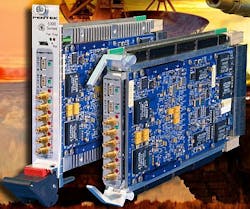D/A converter module for radar and beamformed communications introduced by Pentek
UPPER SADDLE RIVER, N.J., 27 Sept. 2012.Pentek Inc. in Upper Saddle River, N.J., is introducing the Cobalt 71671 D/A converter module for RF and IF waveform playback in multichannel embedded computing applications such as phased array radars and beamformed communications antennas.
The module delivers four independent analog outputs each through its own digital upconverter and 16-bit D/A with sampling rates to 1.25 GHz. An on-board Xilinx Virtex-6 FPGA contains intellectual property that provides turnkey waveform generation for output signal bandwidths from less than 1 kHz up to 250 MHz with an extended interpolation range from 2x to 1,048,576x.
Users also can customize the module's operation by implementing their own IP in the FPGA. The 71671 uses two DAC3484 D/A converters from Texas Instruments, each providing two digital upconverters and 16-bit D/A channels that can translate a quadrature (I+Q) baseband signal to a user-selectable IF (intermediate frequency) center for transmitting.
Complementary synchronizer products can deliver clock and timing signals to several 71671 modules for synchronizing, triggering and gating functions. Synchronization is essential for multichannel applications such as phased array radars and beamformed communications antennas.
The 71671's internal clock generator supports timing modes and operates from an on-board programmable voltage controlled oscillators (VCXO) or an external clock. A front-panel connector accepts a 5 or 10 MHz reference clock to phase lock the internal programmable VCXO. The module also accepts a direct D/A sample clock input.
The 71671 complies with the VITA 42.0 XMC interface specification, providing two gigabit serial connectors. The primary XMC connector supports x4 or x8 PCI Express Gen 2 with several DMA controllers.
The secondary connector supports two 4x or one 8x link with bit rates up to 3.125 GHz to support user-installed gigabit serial protocols such as Aurora, Serial RapidIO, or a secondary PCI Express interface.
For more information contact Pentek online at www.pentek.com.
Follow Military & Aerospace Electronics and Avionics Intelligence news updates on Twitter

